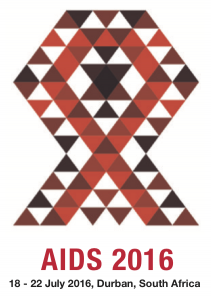Four day a week ART: sub-optimal drug levels but few virological failures
1 October 2016. Related: Conference reports, Treatment strategies, World AIDS 21 Durban 2016.
Simon Collins, HIV i-Base
A poster at IAS 2016 reported on the use of reduced-dose maintenance therapy. This French study involved only taking ART for four rather than seven days a week. [1]
The open-label, single arm, ANRS-162 4D study enrolled 100 people on ART with undetectable viral load (<50 copies/mL) for at least a year on any combination of 2NRTIs and either an NNRTI or a booster-PI. After a one week “reflection” period and four-week screen, participants then switched to taking ART for four consecutive days each week with three days off. Participants were able to choose Monday to Thursday or Tuesday to Friday.
The primary endpoint was confirmed viral rebound >50 copies/mL throughout the 48 week study or discontinuation for more than 30 days for any reason. Secondary endpoints included other safety and laboratory markers, adherence and quality of life.
The study was powered to see 80% efficacy, allowing for a maximum of 10 treatment failures, including five virological failures. An independent Data and Safety Monitoring Board (DSMB) closely reviewed virological failures in real time.
This was a largely male (81%), Caucasian (80%) group. Median age was 47 (IQR 40 to 53) who had been diagnosed for 10 years (IQR 5 to 17), on treatment for 5 years (IQR 3 to 9 years) and virally suppressed for 4 years (IQR 2.3 to 6.4).
NNRTIs were used by 71% (40% efavirenz, 26% rilpivirine and 5% etravirine) and boosted PI’s by 29% (15% darunavir, 13% atazanavir and 1% lopinavir).
By week 48, viral suppression was maintained by 96% participants (95%CI: 90% to 99%). Four participants had therapeutic failure, three with viral rebound (all reporting 100% adherence) and one discontinuation linked to the reduced dose strategy.
The three cases of viral rebound – to 271, 124 and 969 copies/mL – were in people taking lopinavir/r/3TC/abacavir, efavirenz/FTC/tenofovir-DF and atazanavir/r/3TC/abacavir, respectively. All three resuppressed after switching back to full daily dosing (seven days a week). The person discontinuing treatment had a viral load <20 copies/mL and was taking efavirenz/FTC/tenofovir-DF.
Over 48 weeks, liver enzymes improved significantly (reduced ALT, AST and GGT) but other biological markers showed no significant change (renal and lipids). Self-reported adherence to the strategy and a MEMS cap sub-study showed adherence was generally high throughout.
More of a concern were the sub-therapeutic drug levels during the off-periods reported for many participants and most combinations – see Table 1. Having drug levels fall and rise through the risk concentrations when drug resistance can occur must increase the potential risk for treatment failure and drug resistance. Only efavirenz maintained mean drug levels above the therapeutic target, but the standard deviation showed many people would have dropped well below this level.
Background NRTIs might have been more important in this strategy than the choice of NNRTI or PI. Most participants were using TDF/FTC (89%) with 11% (n=11) using abacavir/3TC (and 2/3 viral failures were using abacavir). The long half-life of FTC/tenofovir-DF might therefore providing sufficient safety cover as active dual therapy, as least for much of the 3-day off periods.
A large randomised maintenance study comparing 4/7 to 7/7 dosing is planned to start in early 2017.
| ARV | n | ON mean (SD) | OFF mean (SD) | (OFF-ON) mean change (SD) | p-value |
|---|---|---|---|---|---|
| EFV | 38 | 2218(1046) | 692(391) | -69%(10%) | <0.0001 |
| ETR | 5 | 447(360) | 269(266) | -47%(11%) | 0.0625 |
| RPV | 26 | 106(51) | 39(20) | -63%(13%) | <0.0001 |
| ATV | 12 | 1087(644) | 52(146) | -69%(11%) | 0.0005 |
| DRV | 15 | 2587(1393) | 17(18) | -99%(0) | <0.0001 |
| LPV | 1 | 3922 | 0 | -100% |
Key and target minimum efficacy levels (ng/mL): EFV – efavirenz (>1000); ETR – etravirine (>50); RPV – rilpivirine >40; ATV – atazanavir (>200); DRV – darunavir >2000; LPV – lopinavir >4000.
Comment
The three cases of viral rebound show that this strategy still need much greater study before it could be considered outside of a research setting.
The sub-therapeutic drugs levels are setting ideal circumstances for the development of drug resistance, and not seeing such cases during follow-up might just be due to low power for a small study. An alternative explanation is that FTC/tenofovir-DF provides sufficient continued activity to limit viral rebound.
However, the results could be interpreted as showing that modern ART is likely to retain viral suppression with significantly less than 100% adherence. The results might therefore reduce anxiety associated with missed occasional missed doses in someone who otherwise has a good history of viral suppression.
While other studies have hinted that the three drugs in Atripla have sufficiently long half-lives to cover reduced dosing strategies (see 3-day Atripla study reported above and FOTO etc), the results in this study are underpowered to comment on other combinations. [2, 3]
References:
- de Truchis P et al. Efficacy of a maintenance four-days-a-week regimen, the ANRS162-4D trial. AIDS 2016. Poster THPEB063.
http://programme.aids2016.org/Abstract/Abstract/5947 (Abstract)
http://programme.aids2016.org/PAGMaterial/eposters/0_5947.pdf (PDF poster) - Cohen C et al. The FOTO study: The 48 week extension to assess durability of the strategy of taking efavirenz, tenofovir and emtricitabine Five days On, Two days Off (FOTO) each week in virologically suppressed patients. IAS 2009, Cape Town. Abstract MOPEB063.
http://library.iasociety.org/AbstractView.aspx?confID=2009&abstractId=3046 - Rojas J et al. Three-day per week Atripla maintains viral suppression and decreases sub-clinical toxicity: a pilot study. 18th International Workshop on Comorbidities and Adverse Drug Reactions in HIV, 12-13 September 2016, New York. Oral abstract O22.

